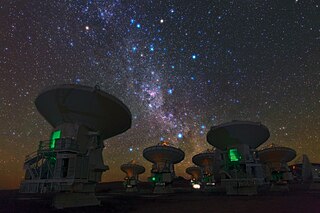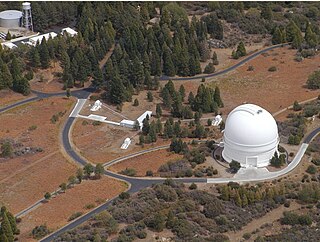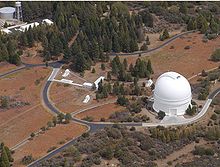
Altair designated α Aquilae, is the brightest star in the constellation of Aquila and the twelfth brightest star in the night sky. It is currently in the G-cloud—a nearby interstellar cloud, an accumulation of gas and dust. Altair is an A-type main sequence star with an apparent visual magnitude of 0.77 and is one of the vertices of the Summer Triangle asterism. It is 16.7 light-years from the Sun and is one of the most visible stars to the naked eye.

Very-long-baseline interferometry (VLBI) is a type of astronomical interferometry used in radio astronomy. In VLBI a signal from an astronomical radio source, such as a quasar, is collected at multiple radio telescopes on Earth or in space. The distance between the radio telescopes is then calculated using the time difference between the arrivals of the radio signal at different telescopes. This allows observations of an object that are made simultaneously by many radio telescopes to be combined, emulating a telescope with a size equal to the maximum separation between the telescopes.

Palomar Observatory is an astronomical research observatory in San Diego County, California, United States, in the Palomar Mountain Range. It is owned and operated by the California Institute of Technology (Caltech). Research time at the observatory is granted to Caltech and its research partners, which include the Jet Propulsion Laboratory (JPL), Yale University, and the National Optical Observatories of China.
Aperture synthesis or synthesis imaging is a type of interferometry that mixes signals from a collection of telescopes to produce images having the same angular resolution as an instrument the size of the entire collection. At each separation and orientation, the lobe-pattern of the interferometer produces an output which is one component of the Fourier transform of the spatial distribution of the brightness of the observed object. The image of the source is produced from these measurements. Astronomical interferometers are commonly used for high-resolution optical, infrared, submillimetre and radio astronomy observations. For example, the Event Horizon Telescope project derived the first image of a black hole using aperture synthesis.

The Navy Precision Optical Interferometer (NPOI) is an American astronomical interferometer, with the world's largest baselines, operated by the Naval Observatory Flagstaff Station (NOFS) in collaboration with the Naval Research Laboratory (NRL) and Lowell Observatory. The NPOI primarily produces space imagery and astrometry, the latter a major component required for the safe position and navigation of all manner of vehicles for the DoD. The facility is located at Lowell's Anderson Mesa Station on Anderson Mesa about 25 kilometers (16 mi) southeast of Flagstaff, Arizona (US). Until November 2011, the facility was known as the Navy Prototype Optical Interferometer (NPOI). Subsequently, the instrument was temporarily renamed the Navy Optical Interferometer, and now permanently, the Kenneth J. Johnston Navy Precision Optical Interferometer (NPOI) – reflecting both the operational maturity of the facility, and paying tribute to its principal driver and retired founder, Kenneth J. Johnston.
11 Aquilae is a single star in the equatorial constellation of Aquila. 11 Aquilae is the Flamsteed designation. It has an apparent visual magnitude of 5.2, which means it is faintly visible to the naked eye. Based upon an annual parallax shift of 20.9 mas, the distance to this star is approximately 156 light-years. The brightness of this star is diminished by 0.33 in magnitude because of extinction from interstellar gas and dust.

27 Aquilae is a star in the equatorial constellation of Aquila. 27 Aquilae is its Flamsteed designation though it also bears the Bayer designation d Aquilae. It has an apparent visual magnitude of 5.49, which is faintly visible to the naked eye. Based upon parallax measurements made during the Hipparcos mission, this star is at a distance of 440 light-years from Earth, give or take a 20 light-year margin of error. At this distance, the brightness of the star is diminished from extinction caused by interstellar gas and dust.

An astronomical interferometer is an array of separate telescopes, mirror segments, or radio telescope antennas that work together as a single telescope to provide higher resolution images of astronomical objects such as stars, nebulas and galaxies by means of interferometry. The advantage of this technique is that it can theoretically produce images with the angular resolution of a huge telescope with an aperture equal to the separation between the component telescopes. The main drawback is that it does not collect as much light as the complete instrument's mirror. Thus it is mainly useful for fine resolution of more luminous astronomical objects, such as close binary stars. Another drawback is that the maximum angular size of a detectable emission source is limited by the minimum gap between detectors in the collector array.
94 Ceti is a trinary star system approximately 73 light-years away in the constellation Cetus.
In optical astronomy, interferometry is used to combine signals from two or more telescopes to obtain measurements with higher resolution than could be obtained with either telescopes individually. This technique is the basis for astronomical interferometer arrays, which can make measurements of very small astronomical objects if the telescopes are spread out over a wide area. If a large number of telescopes are used a picture can be produced which has resolution similar to a single telescope with the diameter of the combined spread of telescopes. These include radio telescope arrays such as VLA, VLBI, SMA, LOFAR and SKA, and more recently astronomical optical interferometer arrays such as COAST, NPOI and IOTA, resulting in the highest resolution optical images ever achieved in astronomy. The VLT Interferometer is expected to produce its first images using aperture synthesis soon, followed by other interferometers such as the CHARA array and the Magdalena Ridge Observatory Interferometer which may consist of up to 10 optical telescopes. If outrigger telescopes are built at the Keck Interferometer, it will also become capable of interferometric imaging.
The Mark III Stellar Interferometer was a long-baseline optical astronomical interferometer, located at the Mount Wilson Observatory, California, United States. It had a maximum baseline of 32 meters and operated in wavelengths between 450 and 800 nm. A joint venture between the United States Naval Observatory, the Naval Research Laboratory, the Smithsonian Astrophysical Observatory, and the Massachusetts Institute of Technology, it began operation in 1987 and was closed in 1992. The Naval Observatory later constructed a larger interferometer, the Navy Prototype Optical Interferometer.

Gerard Theodore van Belle is an American astronomer. He is an expert in optical astronomical interferometry.

The NASA Exoplanet Science Institute (NExScI) is part of the Infrared Processing and Analysis Center (IPAC) and is on the campus of the California Institute of Technology (Caltech) in Pasadena, CA. NExScI was formerly known as the Michelson Science Center and before that as the Interferometry Science Center. It was renamed NExScI in the Fall of 2008 to reflect NASA's growing interest in the search for planets outside of our solar system, also known as exoplanets. The executive director of NExScI is Charles A. Beichman.

Psi3 Piscium, which is Latinized from ψ3 Piscium, is a solitary, yellow-hued star in the zodiac constellation of Pisces. It is faintly visible to the naked eye, having an apparent visual magnitude of 5.562. Based upon an annual parallax shift of 7.5 mas as seen from Earth, it is located about 435 light years from the Sun. At that distance, the visual magnitude is diminished by an extinction factor of 0.33 due to interstellar dust. The star is drifting closer to the Sun with a radial velocity of −7 km/s.

58 Persei is a binary and possibly a triple star system in the northern constellation of Perseus. It has the Bayer designation e Persei, while 58 Persei is the Flamsteed designation. This system is visible to the naked eye as a faint point of light with an apparent visual magnitude of 4.26. It is approximately 800 light years away from the Sun based on parallax, and is drifting further away with a radial velocity of +10 km/s.
13 Trianguli is the Flamsteed designation for a star in the northern constellation of Triangulum. It has an apparent visual magnitude of 5.89, so according to the Bortle scale it is faintly visible from dark suburban skies. The star is located at a distance of 103 light years from the Sun based on parallax measurements, and is drifting further away with a radial velocity of +41 km/s. It made a close approach to the Sun some 665,000 years ago at an estimated separation of 34.3 light-years.

David Robert Ciardi is an American astronomer. He received a bachelor's degree in physics and astronomy from Boston University in 1991, and a Ph.D. in physics from the University of Wyoming in 1997.
64 Piscium is the Flamsteed designation for a close binary star system in the zodiac constellation of Pisces. It can be viewed with the naked eye, with the components having a combined apparent visual magnitude of 5.07. An annual parallax shift of 42.64 mas provides a distance estimate of 46.5 light years. The system is moving further from the Sun with a radial velocity of +3.76 km/s.

Barry Gillespie Clark is an American astronomer who led the development of the world's first digitally recorded, software correlated Very Long Baseline Interferometry (VLBI) system for radio astronomy, the Green Bank Interferometer. He was also heavily involved in the development of the Very Large Array and the Very Long Baseline Array.













